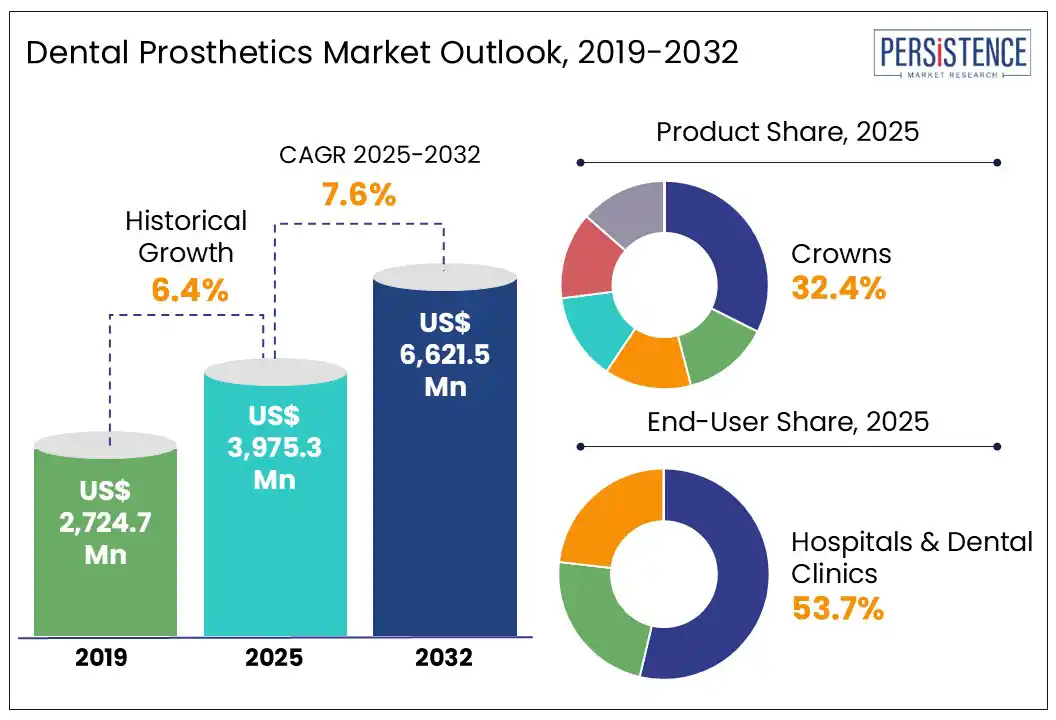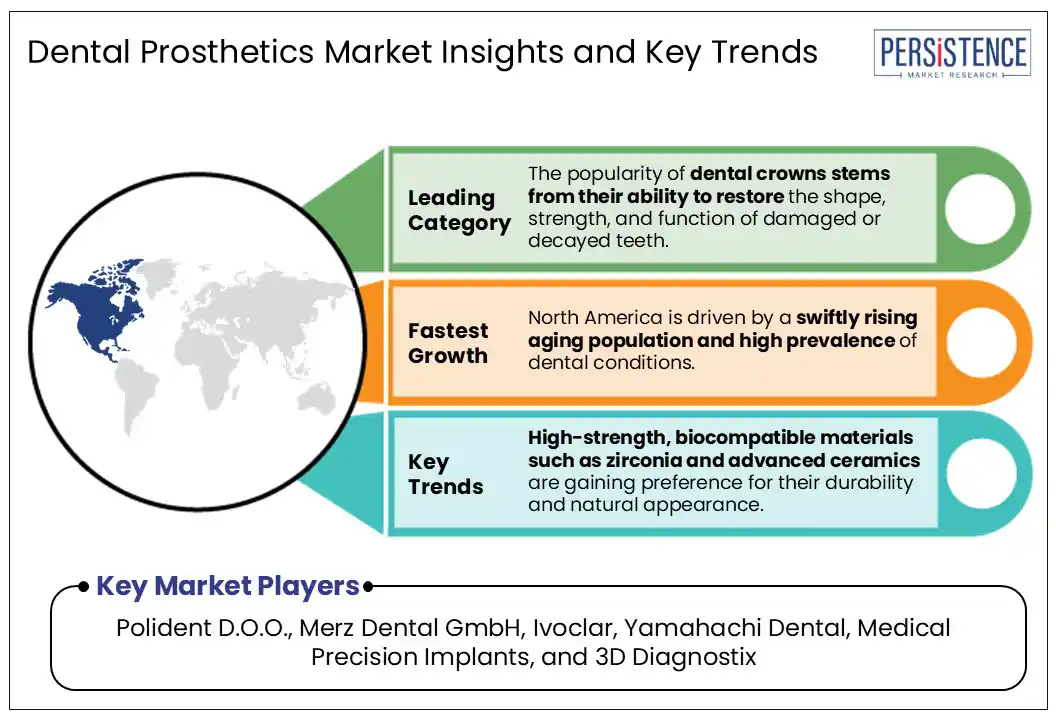ID: PMRREP34819| 198 Pages | 10 Jul 2025 | Format: PDF, Excel, PPT* | Healthcare

The global dental prosthetics market size is likely to be valued at US$ 3,975.3 Mn in 2025 and is estimated to reach US$ 6,621.5 Mn in 2032, at a CAGR of 7.6% during the forecast period 2025 - 2032.
The dental prosthetics market growth is fueled by a growing aging population, rising incidence of dental caries and periodontal diseases, and an increasing demand for cosmetic dental solutions. Dental prosthetics (or prosthodontics) are artificial oral substitutes, such as crowns, bridges, dentures, and implants, designed to restore missing or damaged teeth and support oral health and function. These restorations play a vital role in treating tooth loss, improving aesthetics, and facilitating essential oral functions such as proper speech and chewing.
Technological advancements are significantly enhancing the outlook and prospects of the dental prosthetics market. For example, digital dentistry innovations, such as Computer-Aided Design/Computer-Aided Manufacturing (CAD/CAM) and 3D printing enable faster, more precise fabrication of prosthetic devices. These innovations reduce treatment times and improve patient outcomes. Moreover, the growing popularity of implant-supported prosthetics and abutments, coupled with advanced materials such as zirconia and high-performance ceramics, is creating new opportunities in this market.

Key Industry Highlights:
|
Global Market Attribute |
Key Insights |
|
Dental Prosthetics Market Size (2025E) |
US$ 3,975.3 Mn |
|
Market Value Forecast (2032F) |
US$ 6,621.5 Mn |
|
Projected Growth (CAGR 2025 to 2032) |
7.6% |
|
Historical Market Growth (CAGR 2019 to 2024) |
6.4% |
One of the primary drivers of the dental prosthetics market growth is the increasing geriatric population worldwide. This demographic is highly prone to a range of dental issues such as tooth decay, periodontal disease, and edentulism, leading to dental restorations such as bridges and crowns. According to the World Health Organization’s 2025 oral health data, edentulism affects an estimated 23% of adults aged 60 years and older globally, often resulting from lifelong dental disease and leading to psychological, social, and functional impairments. The rising life expectancy across both developed and emerging economies further sustains this demand for dental prosthetics. Besides this, increasing focus on oral hygiene and a growing preference for functional and aesthetic dental replacements are pushing elderly individuals to seek timely prosthetic care.
The adoption of prosthodontics is majorly hindered by its exorbitant price tag. When it comes to advanced options, such as implant-supported crowns, made from premium materials such as high-strength ceramics, the costs become significantly more prohibitive. These procedures not only involve the cost of the prosthetic device but also include additional charges for diagnostics, surgery, and follow-up care. Furthermore, in several low- and middle-income countries, dental prosthetic procedures are considered elective and are often not covered under public or private health insurance schemes. This lack of reimbursement imposes a financial burden on patients, limiting market penetration.
The integration of digital dentistry and 3D printing technologies offers an exciting growth opportunity for players in the dental prosthetics market. CAD/CAM systems are transforming how prosthetic devices are conceptualized, designed, and fabricated. Such technologies deliver faster turnaround times, greater precision, and enhanced customization. 3D printing, in particular, is emerging as a cost-effective method for producing complex prosthetic structures with high accuracy and minimal waste. Using these technologies, dental professionals are able to offer their services and expertise more efficiently, such as providing same-day restorations, and improving the overall patient experience. As digital tools become more affordable and accessible, manufacturers and clinics can leverage their capacity to expand service delivery, particularly in developing economies where dental infrastructure is rapidly evolving.
On the basis of product, the dental prosthetics market has been divided into dentures, bridges, crowns, dental veneers, inlays & onlays, and others. Among these, the crowns segment is expected to lead with a 32.4% market share over the forecast period. The popularity of dental crowns stems from their versatile usability, such as restoring the shape, strength, and function of damaged or decayed teeth and protecting weakened teeth. The growing global burden of dental caries and tooth fractures, particularly among aging populations, has significantly increased the demand for crowns. Additionally, the integration of crowns with dental implants is broadening their clinical application, bolstering their role in restorative dentistry.
Based on end user, the dental prosthetics market has been segmented into hospitals & dental clinics, dental laboratories, and others. Hospitals & dental clinics are likely to lead, holding a market share of approximately 53.7% in 2025. Hospitals and dental clinics offer a wide range of restorative and cosmetic dental prosthetic services at a single location, and are important for handling complex cases such as implant-supported prosthetics and full-mouth rehabilitation. Moreover, these facilities typically house specialized departments and are equipped with advanced diagnostic and surgical technologies, enabling them to deliver high-precision treatments with better clinical outcomes.

North America is likely to dominate, accounting for approximately 34.2% of the market share over the forecast period, driven by a rapidly expanding aging demographic and high prevalence of dental conditions such as caries and edentulism. The dominance of the region is further strengthened by the rapid uptake of digital dentistry technologies by clinics and laboratories to produce crowns, bridges, and implants more efficiently and accurately. Heavy investments in R&D by manufacturers and a steady demand for prosthodontic solutions further propel the dental prosthetics market in this region.
Europe is experiencing an increasing adoption of advanced dental prosthetics on account of strong healthcare infrastructure and a rising demand for aesthetic dentistry. Regulatory support and reimbursement policies across the European Union (EU) have enabled quicker uptake of implant-supported prosthetics and high-end ceramic crowns. The region also sees increasing use of minimally invasive restorations, driven by shifting patient preferences toward natural-looking implants and advanced material options.
The global dental prosthetics market is characterized by technological innovation and material advancement. Major players are engaged in a cutthroat race to differentiate their offerings by providing faster, more precise, and patient-centric solutions. Companies are also investing heavily in digital dentistry tools such as 3D printing and intraoral scanners to streamline production. There is also a visible preference for aesthetic, metal-free materials such as zirconia and lithium disilicate.
The dental prosthetics market is projected to reach US$ 3,975.3 Mn in 2025.
Rising geriatric population and growing incidence of tooth loss are key market drivers.
The dental prosthetics market is poised to witness a CAGR of 7.6% from 2025 to 2032.
The integration of digital dental technologies with 3D printing and the growing adoption of CAD/CAM in prosthodontic designing and production are key market opportunities.
Major players in the global dental prosthetics market include Polident D.O.O., Merz Dental GmbH, and Ivoclar.
|
Report Attribute |
Details |
|
Historical Data/Actuals |
2019 - 2024 |
|
Forecast Period |
2025 - 2032 |
|
Market Analysis Units |
Value: US$ Mn |
|
Geographical Coverage |
|
|
Segmental Coverage |
|
|
Competitive Analysis |
|
|
Report Highlights |
|
|
Customization and Pricing |
Available upon request |
By Product
By Material
By End-user
By Region
Delivery Timelines
For more information on this report and its delivery timelines please get in touch with our sales team.
About Author